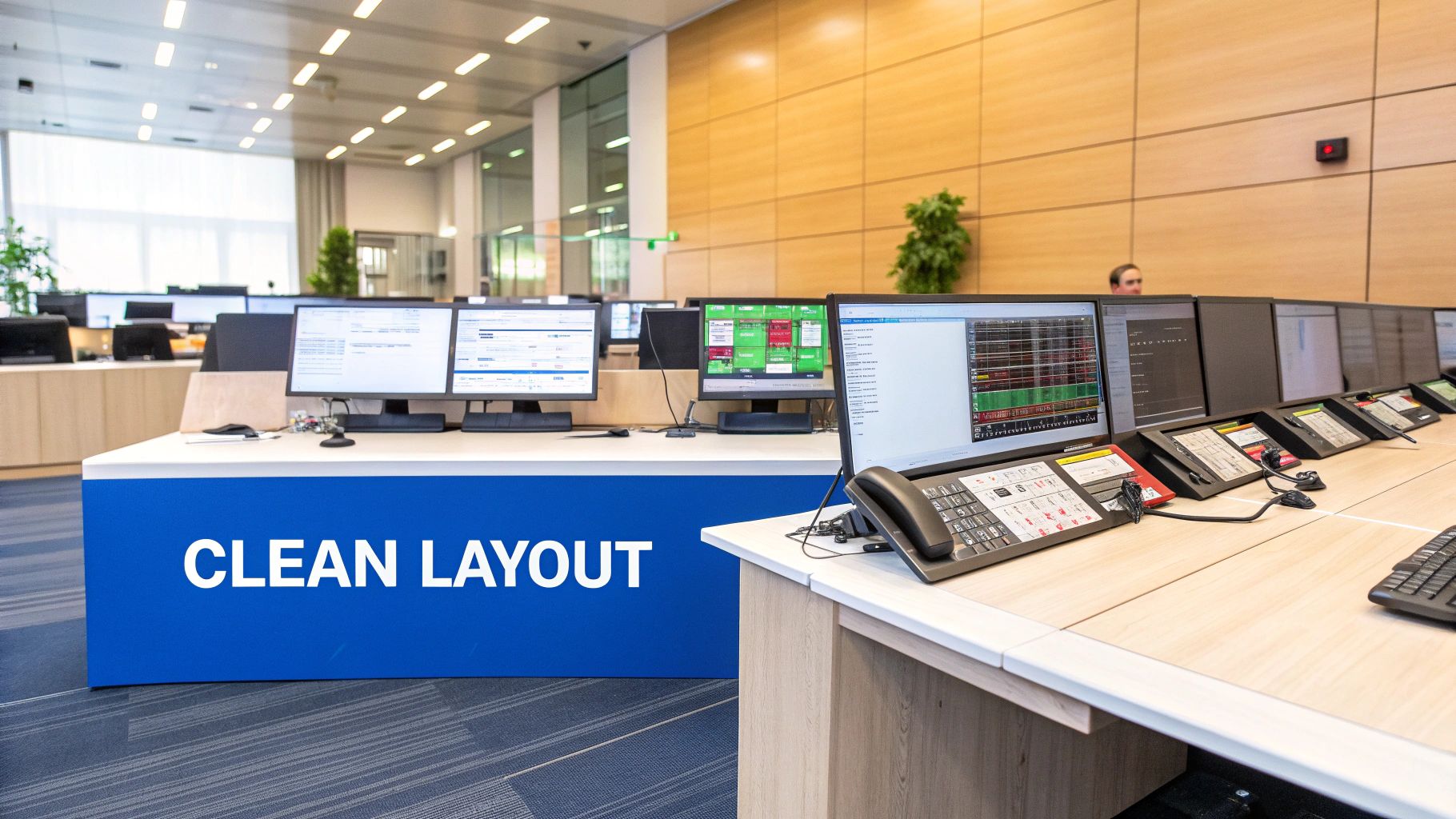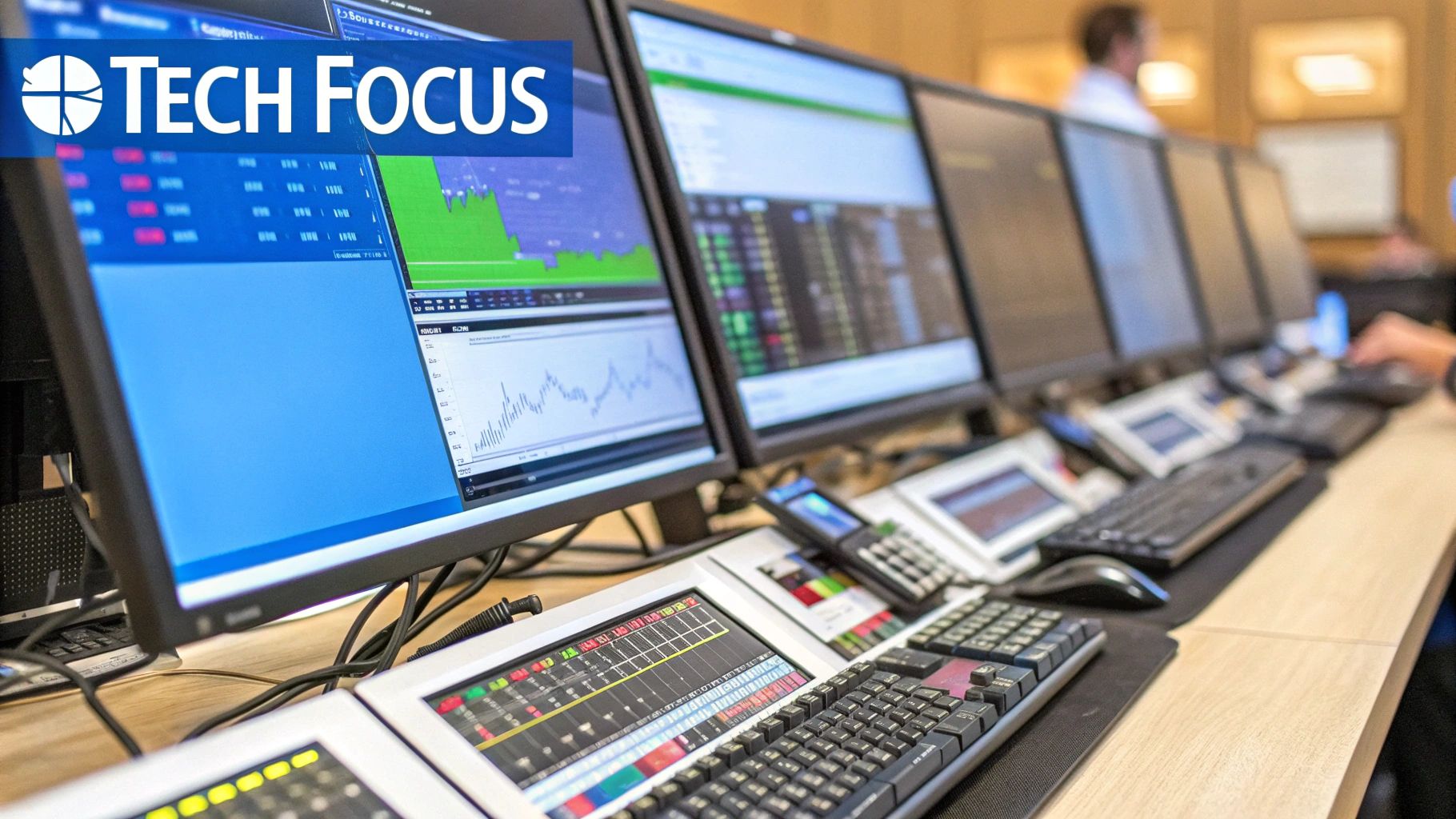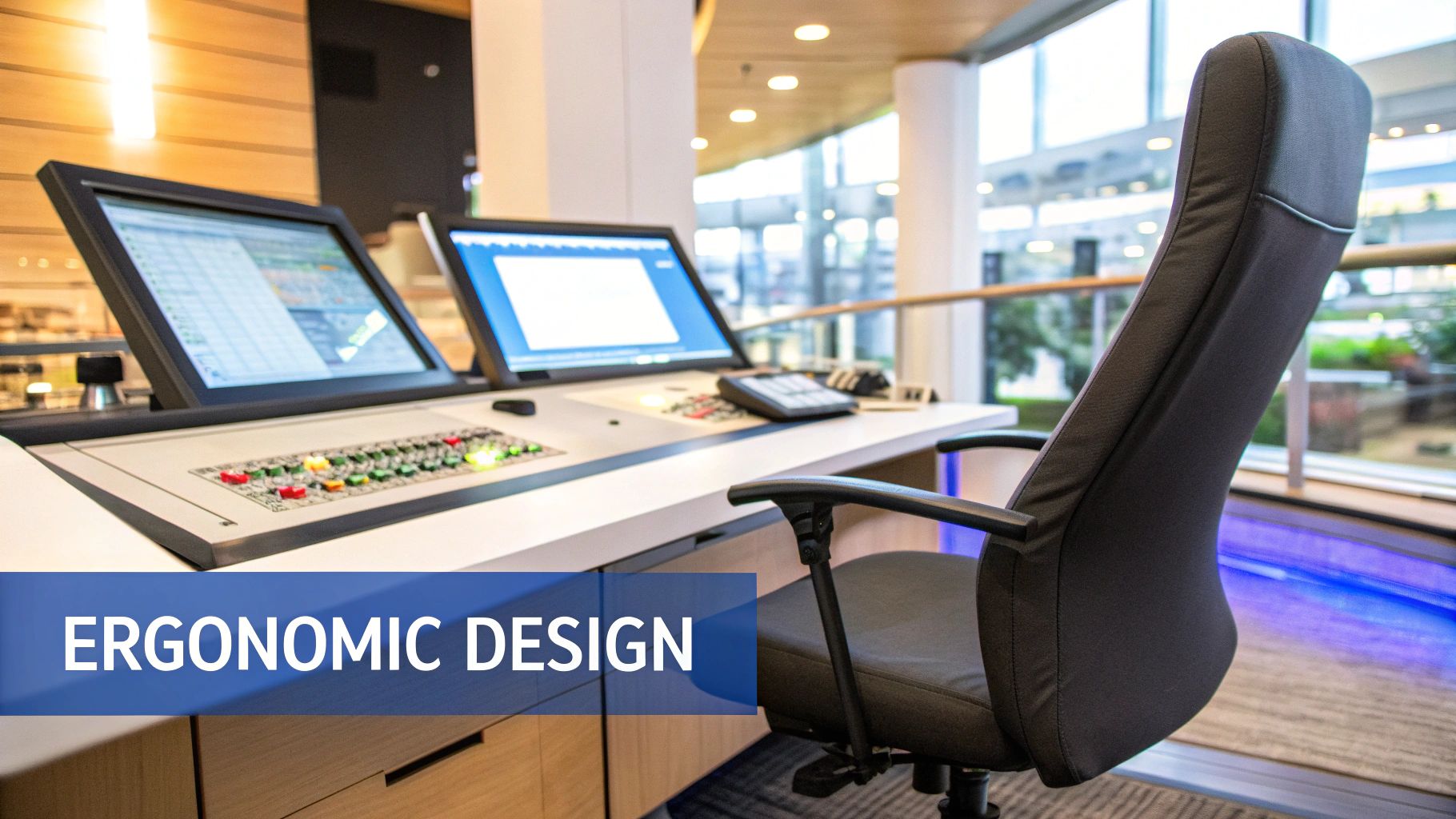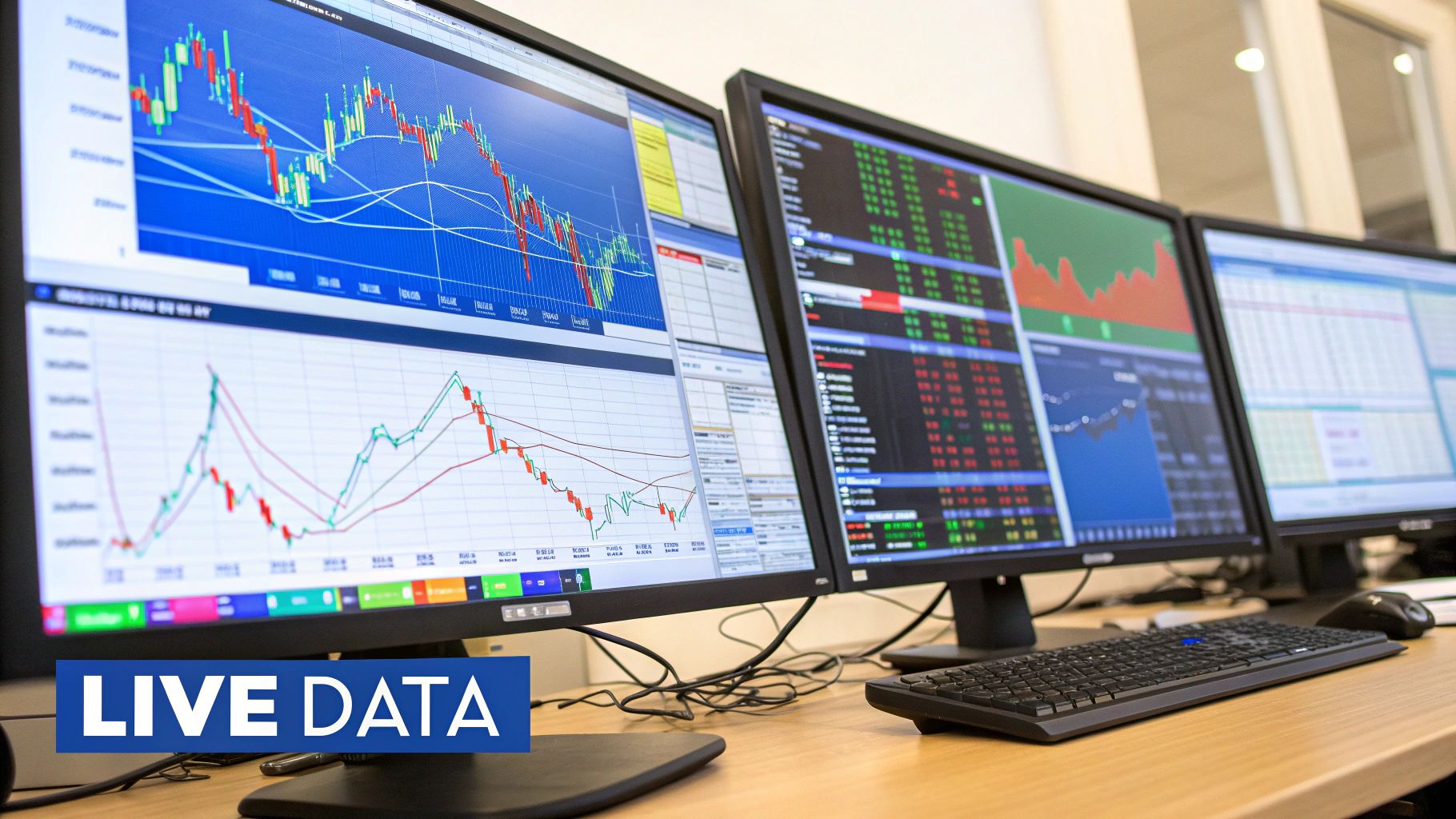Trading Desk Setup: Essential Tips
Core Elements of a High-Performance Trading Desk Setup

A well-designed trading desk setup is essential for any serious trader. It's more than just furniture; it's a central hub where informed decisions are made and executed. Building a high-performance trading desk involves careful consideration of several key elements, each contributing to a productive and efficient trading environment. This section explores the core components that differentiate a professional setup from an amateur one.
The Importance of Multiple Monitors
One of the most obvious distinctions between a professional and amateur trading desk is the number of monitors. A single screen might be enough for casual investors, but active traders need a more comprehensive market overview.
Multiple monitors enable traders to monitor various data streams concurrently, from real-time charts and watchlists to news feeds and order books. This expanded visibility allows for faster responses to market fluctuations and boosts overall trading efficiency.
For example, a day trader could use one screen for charting software like ChartsWatcher, another for Level 2 market data, and a third for their brokerage platform. This multi-faceted approach helps them stay informed and seize opportunities. Furthermore, studies show traders using three or more screens can execute trades up to 27% faster than those with a single screen. These setups often include high-resolution monitors and a powerful GPU for seamless visuals. For a deeper dive into multi-monitor setups, check out this resource: Multi-Monitor Setups for Traders.
Reliable Hardware and Software
A high-performance trading desk requires dependable hardware and software. A powerful computer with a fast processor, ample RAM, and an SSD is crucial for handling real-time data processing and complex charting software. This ensures smooth operation, even during periods of high market volatility.
However, even the most powerful hardware is ineffective without reliable software. Selecting the right trading platform, charting software, and news feed providers can significantly affect trading performance. ChartsWatcher, for instance, offers a robust platform for tracking and analyzing market movements with customizable windows and dashboards, demonstrating the value of feature-rich software.
Ergonomics and Workspace Design
Beyond the technical aspects, the ergonomics of your trading desk are equally important. Long hours spent analyzing charts and making trades can impact your physical health.
A comfortable and ergonomic setup, including a supportive chair, an adjustable desk, and proper lighting, can help prevent fatigue and improve focus. This leads to better decision-making and enhances overall trading performance.
Consider the placement of your monitors to minimize eye strain and neck pain. A clean and organized workspace can also reduce distractions and improve concentration. Cable management solutions, monitor arms, and a well-designed desk layout all contribute to a professional and efficient workspace. Investing in a quality setup that prioritizes your physical well-being is essential for a successful long-term trading career.
Multi-Monitor Mastery: Configurations That Drive Results

Multiple monitors are essential for any serious trader. They offer the visual space needed for effective market analysis and trade execution. This section explores the world of multi-monitor configurations, highlighting optimal setups for various trading strategies. The right setup can significantly improve your trading performance.
Monitor Selection and Positioning
Choosing the right monitors is key for an efficient trading desk. Size and resolution are critical factors. A larger primary monitor, typically 27-32 inches, provides ample space for charting and analysis. Secondary monitors can be smaller, around 24 inches, ideal for watchlists, news feeds, and order books.
Resolution impacts clarity. A 4K resolution on your main monitor enhances detail, while 1440p is generally sufficient for secondary screens. Proper monitor placement is equally important. An ergonomic arrangement reduces neck strain and promotes comfortable viewing of all screens. This improves focus and minimizes fatigue during long trading sessions. Prioritize easy access to critical information for seamless transitions between data points.
Organizing Your Screens for Peak Performance
The way you organize information across your monitors is vital. Many successful traders dedicate their main monitor to charting and technical analysis. They often utilize platforms like ChartsWatcher, which allows for customized windows and dashboards.
Secondary monitors are typically used for market depth, order books, news, and even social media sentiment analysis. This lets traders monitor broader market trends while focusing on specific trades. For instance, a day trader might use one screen for real-time charts, another for Level 2 market data, and a third for their order entry platform. This streamlined organization enhances reaction time and decision-making.
An immersive setup offers psychological benefits as well. Having all necessary information readily visible can create a more engaging and productive trading environment. Learn more about multi-monitor trading setups in this helpful article: How to master multiple monitor trading setups.
Avoiding Overkill and Finding Your Sweet Spot
More monitors might seem better, but there's a point of diminishing returns. Too many screens can cause information overload and hinder decision-making. Finding your ideal setup is essential. Experiment to determine what best suits your trading style and cognitive preferences.
A three-monitor setup is a good starting point, offering a balance of information and manageability. Some traders, however, prefer four, five, or even six monitors. The goal is to maximize productivity without losing focus. Invest in a quality setup that balances functionality and simplicity. Remember, an efficient trading desk is about the quality of information and its effective use, not just the number of monitors.
The following table provides a comparison of different multi-monitor setups. It outlines the benefits, costs, and ideal applications for each configuration, helping you determine the best fit for your trading needs.
Monitor Configuration Comparison for Traders
| Setup Type | Number of Monitors | Ideal Layout | Best For | Approximate Cost | Space Required |
|---|---|---|---|---|---|
| Basic | 2 | One horizontal, one vertical | Beginners, casual traders | $500 - $1000 | Moderate |
| Standard | 3 | One horizontal in the center, two vertical on the sides | Day traders, swing traders | $800 - $1500 | Moderate to Large |
| Advanced | 4+ | Curved or wrapped around the user | Active traders, multi-market analysis | $1200+ | Large |
This table summarizes various monitor configurations, from basic two-monitor setups to more advanced arrangements. Consider your budget, space constraints, and trading style when making your decision. A well-planned setup can significantly impact your trading success.
Trading Hardware That Won't Let You Down

A truly effective trading desk requires more than just a multi-monitor setup. In the fast-paced world of financial markets, your hardware needs to be just as quick. This section explores the key components you need for a system that performs flawlessly under pressure, focusing on what truly delivers optimal trading results.
Processing Power and Memory: The Engine of Your Setup
Your computer is the core of your trading operation. A powerful processor is essential for handling real-time data feeds, sophisticated charting software like ChartsWatcher, and numerous applications running simultaneously. Aim for a processor with at least six cores to ensure smooth operation, especially when market volatility is high.
Sufficient RAM is also critical for seamless multitasking. We recommend a minimum of 32GB of RAM for a modern trading setup. This allows your system to manage multiple data streams, charts, and applications without frustrating lags or crashes, keeping you in the game during crucial trading moments. For more ideas, check out: 10 Best Day Trading Setups.
Storage Solutions: Speed and Reliability
Fast storage is key for quickly accessing your trading platform, market data, and applications. A Solid State Drive (SSD) offers considerably faster read and write speeds than a traditional Hard Disk Drive (HDD). This means faster boot times, quicker loading of applications, and a more responsive trading experience overall.
Use a large SSD as your primary drive for your operating system and trading software to maximize efficiency. A larger HDD can serve as a secondary drive for archiving older data. This combination gives you both speed and ample storage space.
Network Connectivity: The Lifeline of Your Trades
A reliable internet connection is paramount. High-speed internet, ideally fiber optic, minimizes latency and ensures you receive real-time market data without delay. Network latency directly impacts your trading performance, so a lower latency connection means faster, more accurate trade execution.
A backup internet connection is also essential for redundancy, protecting you from expensive downtime should your primary connection fail. This backup allows uninterrupted trading, even during unexpected outages. Modern setups also rely on sophisticated mathematical models that use data collection for real-time feeds and indicators such as MACD and RSI. For a deeper dive into this topic, see: Trading Desk Setup Insights.
Redundancy and Backup: Protecting Your Investments
Hardware failures can happen at the worst possible moment. Redundancy is, therefore, vital for any serious trading setup. Having a backup computer ready to go ensures minimal disruption should your primary machine malfunction.
Regularly backing up your data to an external hard drive or cloud storage is also highly recommended. This protects your valuable trading data from loss due to hardware failure or other unexpected events. A comprehensive backup strategy is essential for safeguarding your trading information and maintaining business continuity.
Trading Software Ecosystem: Beyond the Basics

Building a successful trading desk setup goes beyond simply having the right hardware. The software you choose plays a crucial role in gaining a competitive edge. This means looking beyond basic trading platforms and exploring specialized tools that enhance your workflow and decision-making process. This section explores the essential software components professional traders use for market analysis, risk management, automation, and performance tracking.
Essential Software Components For The Modern Trader
A comprehensive trading software ecosystem usually involves several key elements working together. These components aim to provide traders with a complete market overview and empower them to make well-informed decisions.
-
Market Analysis Software: This type of software offers more than just basic charting. It often includes advanced features like technical indicators, statistical analysis, and even AI algorithms. Many traders rely on platforms like ChartsWatcher for in-depth analysis, customizable windows, and dynamic dashboards.
-
Risk Management Software: This is essential for protecting your capital and managing risk effectively. Features often include position sizing tools, stop-loss order management, and real-time risk analytics. This software helps traders understand and control potential losses, ensuring they stay within their predefined risk parameters.
-
Automation Software: For those using automated trading strategies, automation software is vital. This software automates trade execution, backtests strategies, and manages algorithmic trading systems. Options range from simple scripting tools to complex algorithmic trading platforms.
-
Performance Tracking Software: Understanding your trading performance over time is key to improvement. Performance tracking software allows traders to monitor profit and loss, analyze trading statistics, and identify areas for refinement.
To illustrate the differences between some popular trading platforms, take a look at the comparison table below. It outlines the key features, pricing models, and suitability for various trading styles.
Trading Platform Feature Comparison
| Platform | Best For | Charting Capabilities | Commission Structure | API Availability | Mobile Support | User Interface |
|---|---|---|---|---|---|---|
| ChartsWatcher | Day trading, swing trading | Advanced charting, custom indicators, drawing tools | Varies based on subscription | Yes | Yes | Customizable, user-friendly |
| TradingView | Technical analysis, global markets | Extensive charting tools, multi-timeframe analysis | Free and paid versions | Yes | Yes | Modern, intuitive |
| TC2000 | Active trading, technical analysis | Customizable charting, options analysis | Subscription-based | Yes | Yes | Functional, reliable |
| Thinkorswim | Options trading, complex strategies | Advanced charting, options analytics, strategy backtesting | Commission-based | Yes | Yes | Powerful, but complex |
As shown in the table, different platforms cater to different needs and trading styles. ChartsWatcher offers excellent real-time data and analysis, while platforms like TradingView provide advanced charting for technical traders. TC2000, with its long-standing reputation, focuses on speed and customizability. Finally, Thinkorswim stands out with its robust options trading capabilities.
Evaluating Trading Software: Beyond Flashy Features
When choosing software for your trading desk, prioritize reliability and how well it integrates into your existing workflow. Don't be swayed by unnecessary features. Instead, focus on software that seamlessly integrates with your current setup and genuinely improves your overall trading process.
Consider factors like robust customer support, regular updates, and a user-friendly interface. These are as important, if not more so, than a wide array of complex features.
Software Integration And Platform Switching
Minimizing platform switching is a critical aspect of software selection. Constantly switching between different applications can be distracting and eat into valuable trading time. Look for tools that can share data or integrate with each other to streamline your workflow.
For instance, using a charting platform that integrates with your brokerage account can significantly streamline order entry and execution, saving you time and potentially boosting your trading efficiency.
Emerging Trading Tools And Technologies
The trading software landscape is constantly evolving. New tools and technologies regularly emerge, offering traders innovative ways to analyze markets, manage risk, and automate strategies. Staying up-to-date on these developments and understanding their potential impact on your trading setup is crucial. For example, AI-powered tools are becoming increasingly popular for their ability to analyze large datasets and identify patterns in market data.
Staying informed can provide you with a distinct advantage. By researching and adopting new tools, you can continually optimize your trading desk setup for maximum efficiency and performance. Adaptability is key to success in the dynamic world of trading.
Network Infrastructure: The Unseen Trading Edge
In the fast-paced world of trading, milliseconds matter. Profits and losses can hinge on lightning-fast execution. This means your network infrastructure is more than just a background element; it's a crucial part of your trading setup. Let's explore how optimizing your connectivity can give you a true trading advantage.
The Impact of Latency on Execution Quality
Latency, the delay between order and execution, can significantly impact your trading results. In high-frequency trading, even a few milliseconds can make all the difference. For strategies using platforms like ChartsWatcher for real-time data and order execution, minimizing latency is paramount.
Lower latency means faster responses to market changes, leading to improved execution quality and increased profit potential. Optimizing your network for minimal latency is therefore essential. This can involve choosing high-speed internet and positioning servers closer to the exchanges you use.
Backup Solutions for Network Outages
Network outages are unfortunately a reality. But their impact can be lessened with the right backup solutions. A redundant internet connection, like a separate DSL or 4G line, is vital. This secondary connection automatically kicks in if your primary one fails, maintaining your access to market data and trading platforms.
A backup power supply, such as a UPS, also provides crucial protection against power failures. This prevents data loss and ensures continuous connectivity during critical trading moments.
Security Considerations for Protecting Your Capital
Protecting your trading capital from cyber threats is paramount. A secure network is fundamental to preventing unauthorized access to accounts and financial data.
This includes using strong firewalls and passwords, and keeping your software updated with the latest security patches. Staying vigilant against phishing scams and other social engineering tactics is equally crucial.
Cost-Effective Approaches and Specialized Trading Networks
Improving connection reliability doesn't always require expensive solutions. Simple steps like optimizing your Wi-Fi router's location or switching to a wired connection can significantly reduce latency and boost stability.
For some traders, particularly those involved in high-frequency trading, a dedicated trading network offers a significant advantage, though it comes at a cost. These networks provide ultra-low latency and enhanced security, giving you a real edge in competitive markets. Regularly testing your network setup helps identify and address any weaknesses proactively.
Building Your Proprietary Trading Environment
Moving beyond a home office and establishing a proprietary trading environment offers significant advantages for serious traders. This transition involves creating a professional operation, complete with the necessary legal and infrastructural framework. This section outlines a practical roadmap for achieving this, drawing inspiration from the success of established independent trading firms.
Legal and Regulatory Foundations
A crucial first step in establishing your proprietary trading desk is registering as a legal entity, such as a Limited Liability Company (LLC). This provides structure and is often required for accessing financial markets and data feeds.
Understanding the regulatory landscape is also essential for long-term success. This includes staying informed about licensing requirements, compliance regulations, and any legal obligations specific to your region and trading activities. These initial steps lay the groundwork for a sustainable and compliant trading operation.
Establishing a proprietary trading desk requires careful planning, beginning with legal registration. This setup necessitates access to financial markets, enabling comprehensive data analysis and effective trade execution. While proprietary trading desks offer the advantage of retaining all profits, they also demand substantial initial capital and a well-defined financial plan. Learn more about building a proprietary trading desk here: QuantInsti Blog - Proprietary Trading Desk.
Securing Institutional-Grade Tools and Data
Access to high-quality tools and data is paramount for a professional trading environment. This includes robust trading platforms, real-time and historical market data feeds, sophisticated risk management systems, and advanced analytical software.
While acquiring these resources might seem costly, there are practical approaches for traders with reasonable budgets. For example, platforms like ChartsWatcher offer powerful charting and analysis tools, customizable dashboards, and real-time data integration with flexible pricing.
Exploring different vendors and comparing their features helps you find the optimal solution for your needs and budget. Investing wisely in essential tools and data empowers you to make more informed trading decisions.
Risk Management and Operational Strategies
Effective risk management is critical for protecting your capital and ensuring long-term success. This involves implementing strong risk management frameworks, setting clear trading rules, and consistently monitoring performance. Diversification, position sizing, and stop-loss orders are a few vital risk management practices.
Streamlining your operational strategies is equally important. This minimizes administrative burdens and allows you to focus on core trading activities. Efficiently managing your time, automating routine tasks, and outsourcing non-essential functions can free up valuable time and mental energy for market analysis and trade execution.
Team Dynamics and Sustainable Growth
For larger proprietary trading firms, building a skilled and collaborative team is essential for sustainable growth. This typically involves hiring experienced traders, quantitative analysts, risk managers, and IT specialists.
Clearly defined roles, effective communication, and a collaborative environment are key to a successful team dynamic. Continuous learning and adaptation are also crucial for staying competitive. Regularly reviewing your strategies, staying current with market trends, and adapting to new technologies are essential for long-term growth and success in proprietary trading.
Trader-Focused Ergonomics: Designing For Longevity
Trading requires intense focus for extended periods. Your physical environment should support this, not hinder it. This section explores how professional traders design their workspaces for better performance and to prevent physical strain.
Desk Configuration: The Foundation of Comfort
Your desk is the centerpiece of your trading setup. An adjustable standing desk offers the flexibility to switch between sitting and standing, which promotes better circulation and reduces back pain. The correct height is essential. Your elbows should be at a 90-degree angle when typing, and your monitors should be positioned at eye level to minimize neck strain.
Cable management is also important. A clean, organized workspace minimizes distractions and improves concentration. This is especially helpful when using real-time data and charting software such as ChartsWatcher.
Seating Selection: Investing in Long-Term Support
A supportive chair is an investment in your long-term health and trading performance. Look for a chair with adjustable lumbar support, armrests, and seat height.
Proper posture is essential. Ensure your feet are flat on the floor or on a footrest and your back is straight against the backrest. This allows for better blood flow and reduces fatigue, crucial during long trading sessions.
Lighting Design: Optimizing For Visual Clarity
Proper lighting minimizes eye strain and improves focus. Natural light is ideal, so position your desk near a window if possible, but avoid glare on your screens. Use blinds or curtains to control light levels. Supplement natural light with adjustable desk lamps to prevent eye fatigue, particularly in darker environments or during evening trading.
Additionally, the color temperature of your lighting matters. Cooler light (5000-6500K) can boost alertness, while warmer light (2700-3000K) promotes relaxation. Experiment to find what works best for your focus and energy levels throughout the day. This is particularly relevant for traders using visually intensive platforms like ChartsWatcher.
Movement and Breaks: Counteracting The Sedentary Lifestyle
Trading is a largely sedentary activity, so incorporating movement into your routine is crucial. Take regular breaks to stand, stretch, or walk around. Even short breaks can significantly improve circulation and reduce stiffness.
For example, set a timer to remind yourself to stand up every 30 minutes. Consider using a standing desk mat to reduce fatigue while standing. These small adjustments can significantly improve your long-term health and well-being, helping sustain focus and prevent burnout.
Budget-Friendly Ergonomic Improvements
Improving your trading desk ergonomics doesn't require a huge investment. Simple changes can make a big difference. For example, a stack of books can raise your monitor to eye level, and a tennis ball taped to your chair can provide temporary lumbar support.
For limited spaces, a monitor arm can free up desk space and improve monitor positioning. As your budget allows, invest in better equipment, like an ergonomic keyboard and mouse, to further enhance your comfort and trading performance.
Ready to elevate your trading setup with real-time data analysis and custom charting? Explore the powerful features of ChartsWatcher today and discover how it can enhance your trading performance.

